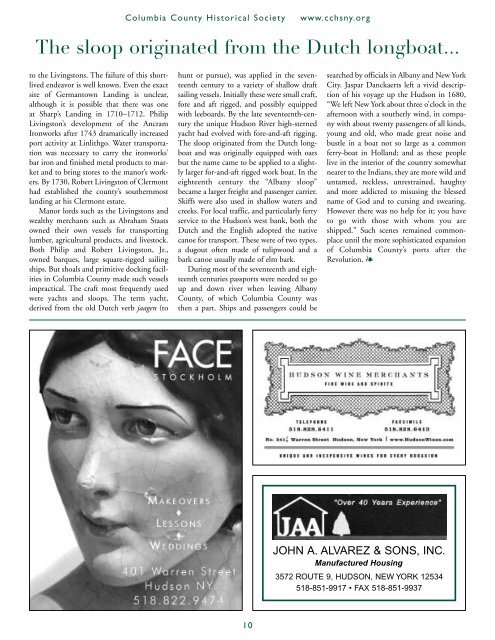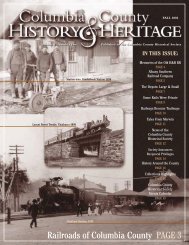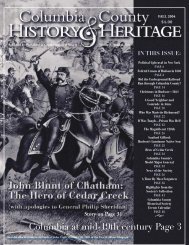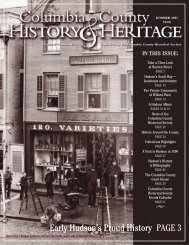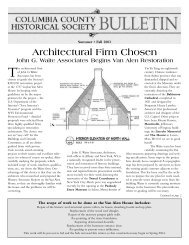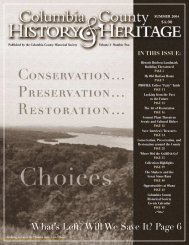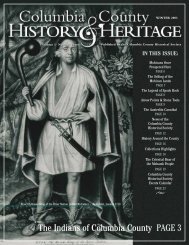Our Incrredible Valley Page 3 - Columbia County Historical Society
Our Incrredible Valley Page 3 - Columbia County Historical Society
Our Incrredible Valley Page 3 - Columbia County Historical Society
Create successful ePaper yourself
Turn your PDF publications into a flip-book with our unique Google optimized e-Paper software.
to the Livingstons. The failure of this shortlived<br />
endeavor is well known. Even the exact<br />
site of Germantown Landing is unclear,<br />
although it is possible that there was one<br />
at Sharp’s Landing in 1710–1712. Philip<br />
Livingston’s development of the Ancram<br />
Ironworks after 1743 dramatically increased<br />
port activity at Linlithgo. Water transportation<br />
was necessary to carry the ironworks’<br />
bar iron and finished metal products to market<br />
and to bring stores to the manor’s workers.<br />
By 1730, Robert Livingston of Clermont<br />
had established the county’s southernmost<br />
landing at his Clermont estate.<br />
Manor lords such as the Livingstons and<br />
wealthy merchants such as Abraham Staats<br />
owned their own vessels for transporting<br />
lumber, agricultural products, and livestock.<br />
Both Philip and Robert Livingston, Jr.,<br />
owned barques, large square-rigged sailing<br />
ships. But shoals and primitive docking facilities<br />
in <strong>Columbia</strong> <strong>County</strong> made such vessels<br />
impractical. The craft most frequently used<br />
were yachts and sloops. The term yacht,<br />
derived from the old Dutch verb jaagen (to<br />
<strong>Columbia</strong> <strong>County</strong> <strong>Historical</strong> <strong>Society</strong> www.cchsny.org<br />
The sloop originated from the Dutch longboat...<br />
hunt or pursue), was applied in the seventeenth<br />
century to a variety of shallow draft<br />
sailing vessels. Initially these were small craft,<br />
fore and aft rigged, and possibly equipped<br />
with leeboards. By the late seventeenth-century<br />
the unique Hudson River high-sterned<br />
yacht had evolved with fore-and-aft rigging.<br />
The sloop originated from the Dutch longboat<br />
and was originally equipped with oars<br />
but the name came to be applied to a slightly<br />
larger for-and-aft rigged work boat. In the<br />
eighteenth century the “Albany sloop”<br />
became a larger freight and passenger carrier.<br />
Skiffs were also used in shallow waters and<br />
creeks. For local traffic, and particularly ferry<br />
service to the Hudson’s west bank, both the<br />
Dutch and the English adopted the native<br />
canoe for transport. These were of two types,<br />
a dugout often made of tulipwood and a<br />
bark canoe usually made of elm bark.<br />
During most of the seventeenth and eighteenth<br />
centuries passports were needed to go<br />
up and down river when leaving Albany<br />
<strong>County</strong>, of which <strong>Columbia</strong> <strong>County</strong> was<br />
then a part. Ships and passengers could be<br />
10<br />
searched by officials in Albany and New York<br />
City. Jaspar Danckaerts left a vivid description<br />
of his voyage up the Hudson in 1680,<br />
“We left New York about three o’clock in the<br />
afternoon with a southerly wind, in company<br />
with about twenty passengers of all kinds,<br />
young and old, who made great noise and<br />
bustle in a boat not so large as a common<br />
ferry-boat in Holland; and as these people<br />
live in the interior of the country somewhat<br />
nearer to the Indians, they are more wild and<br />
untamed, reckless, unrestrained, haughty<br />
and more addicted to misusing the blessed<br />
name of God and to cursing and swearing.<br />
However there was no help for it; you have<br />
to go with those with whom you are<br />
shipped.” Such scenes remained commonplace<br />
until the more sophisticated expansion<br />
of <strong>Columbia</strong> <strong>County</strong>’s ports after the<br />
Revolution. �<br />
JOHN A. ALVAREZ & SONS, INC.<br />
Manufactured Housing<br />
3572 ROUTE 9, HUDSON, NEW YORK 12534<br />
518-851-9917 • FAX 518-851-9937


